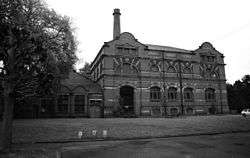Ollerton and Boughton
Ollerton and Boughton is a civil parish and town in the Newark and Sherwood district of Nottinghamshire, England. The population of the civil parish at the 2011 Census was 9,840.[1]
Ollerton village
Ollerton, originally known as Alreton or Allerton, meaning 'farm among the alders', is situated at the crossroads of the York to London, Worksop to Newark, and Lincoln to Mansfield roads. Due to its location, in mediaeval times the village became a meeting place for forest officials, commissioners and Justices of the Peace, leading to the development of its two coaching inns, The White Hart and The Hop Pole. For many years, the main occupation in Ollerton was hop growing – there were hop fields along the River Maun from as early as 1691 and a weekly hop market was held in the village on Fridays.
The Markhams – a land owning family – were highly influential in the village's development. They built and lived in Ollerton Hall and the story of their life during the Civil War is immortalised in a book by Elizabeth Glaister.
Throughout the centuries, watermills have played an important part of life in Ollerton; today the only working watermill in Nottinghamshire can be found in the village, built in 1713 on the same spot as one of those listed in the Domesday Book.
New Ollerton
Originally built as a colliery village in the mid-1920s, New Ollerton was once acclaimed in the Spectator magazine as 'an admirable industrial housing scheme' – also known as a 'model village'. Miners enjoyed a high standard of living, with semi-detached houses, large gardens and hot water supplied directly from the pit. Times have changed – the mine closed in 1994 – but New Ollerton still possesses an innovative nature and the colliery has been replaced by 'The Sherwood Energy Village', which has received media attention for its environmental principles.
When Ollerton colliery was opened in the 1920s, red house bungalows were built on Newark Road to house the shaft sinkers. These were not as attractive as they sound - medium-sized nissen huts made from corrugated steel. They were then used by the first colliers and their families until the first pit houses were built, on Poplar Street, Pine Avenue, Oak Avenue, Sycamore Road and Birch Road. These were the first and had the added bonus of having constant hot water supplied from the colliery. Later when the colliery was recruiting more men, the new miners moved to Ollerton without their wives and children and went into lodgings until more houses were built. This was a boom time for Ollerton and the surrounding villages and towns who were also opening new pits. Ollerton pit was originally owned by the Butterly company until nationalisation in 1947. In the mining villages of the 1930s and 1940s, big families ruled the day and Ollerton was no exception with 9 and 10 children being quite common. The Whittons were one of those with 10 children. After serving for 5 years in the Sherwood Foresters, Bill Whitton moved to Ollerton to work at the pit. Bill was stinting on the pit face until his 50s. Stinting is digging coal on the pit face with a pick and shovel in temperatures reaching one hundred degrees. A lot of the older miners who worked in the mines in the early years suffered from respiratory diseases. In the late 1950s and early 1960s, the vast majority of mines in the north east and quite a few in Derbyshire were closed, which meant an influx of miners to Ollerton. 800 more colliery houses were built and Ollerton grew and grew. In November 1964, Ollerton and Bevercotes miners welfare opened at a cost of £125,000. It was known as the palladium of the Midlands, with huge stars of the time appearing there. Johnny Ray was the opening act, a huge star from America singing in a club in a mining village. The welfare has now been demolished.
Boughton

Boughton (pronounced 'Booton') is recorded in the Domesday Book and has had a varied history: it has played host to Viking invaders and Italian and German prisoners of war, and at one stage formed part of the vast Rufford Estate.
Originally a small hamlet centred on St Matthew's Church, farming was the main occupation until the 1930s, when the face of Boughton began to change dramatically. The sinking of Ollerton Colliery and the housing stock that followed means that today the boundary between New Ollerton and Boughton can be difficult to recognise. A noted architectural feature of the area is the listed Edwardian Boughton Pumping Station, which formerly supplied over three million gallons of clean water each day to homes in the city of Nottingham.
History and amenities
There is an Army Cadet Force and a community band.
There is a small high street with shops incluring a post office, chemist, banks and grocery stores. There is also a shopping area on Sherwood Drive which includes charity shops and an indoor market. This is also the home of the town hall and Lifespring Centre, which is a local charitable community venue and cafe. There are local churches including Lifespring Church, St Paulinus and the Methodist Church which also acts as the local food bank.
References
- ↑ "Civil Parish population 2011". Neighbourhood Statistics. Office for National Statistics. Retrieved 6 April 2016.
External links
Coordinates: 53°12′21″N 1°00′28″W / 53.2058°N 1.0078°W